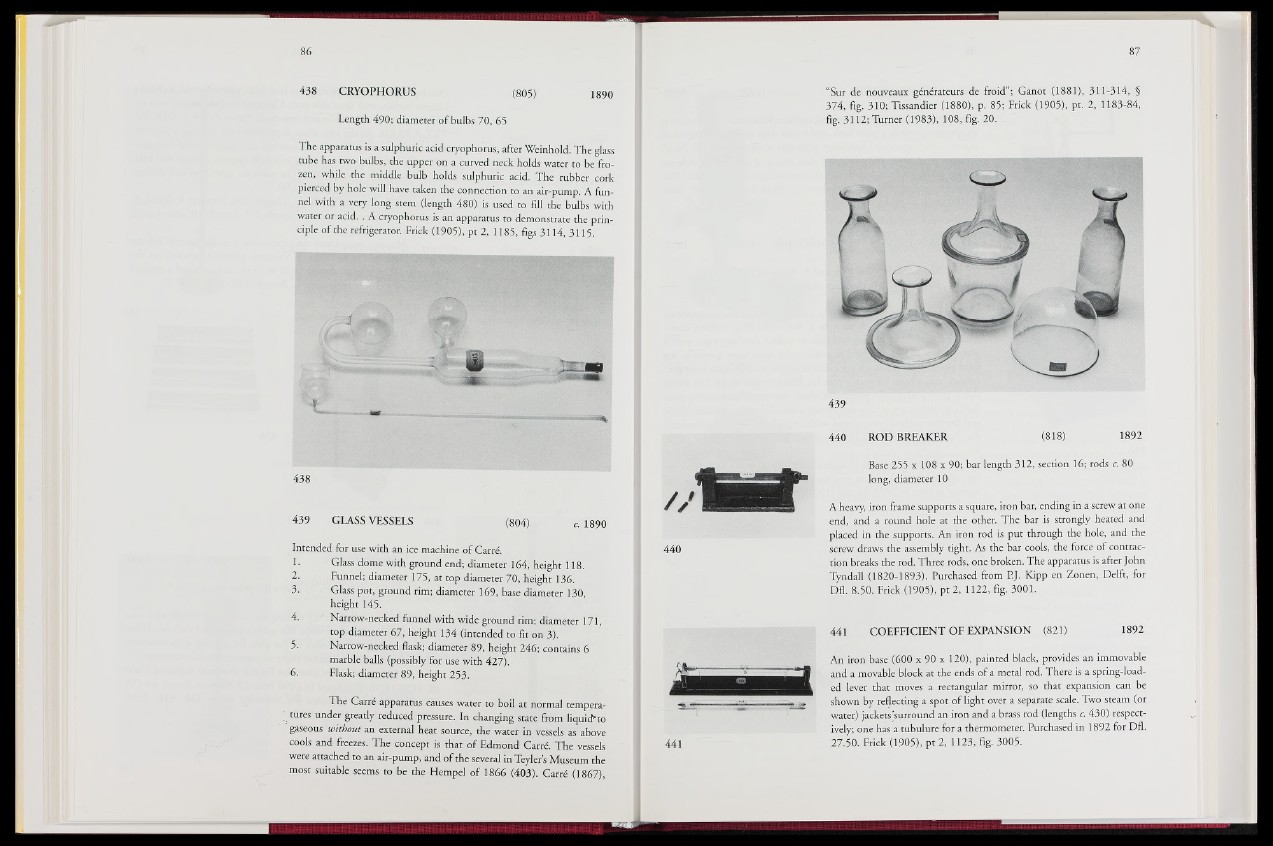
438 CRYOPHORUS (805) 1890
Length 490; diameter of bulbs 70, 65
The apparatus is a sulphuric acid cryophorus, after Weinhold. The glass
tube has two bulbs, the upper on a curved neck holds water to be frozen,
while the middle bulb holds sulphuric acid. The rubber cork
pierced by hole will have taken the connection to an air-pump. A funnel
with a very long stem (length 480) is used to fill the bulbs with
water or acid. . A cryophorus is an apparatus to demonstrate the principle
of the refrigerator. Frick (1905), pt 2, 1185, figs 3114, 3115.
i
438
439 GLASS VESSELS (804) c. 1890
Intended for use with an ice machine of Carré.
1 • Glass dome with ground end; diameter 164, height 118.
2 . Funnel; diameter lgg, at top diameter 70, height 136.
3. Glass pot, ground rim; diameter 169, base diameter 130,
height 145.
4. ' Narrow-necked funnel with wide ground rim; diameter 171,
top diameter 67, height 134 (intended to fit on 3).
5. Narrow-necked flask; diameter 89, height 246; contains 6
marble balls (possibly for use with 427).
6. Flask; diameter 89, height 253.
The Carre apparatus causes water to boil at normal tempera-
tures under greatly; reduced pressure. In changing state from liquidato
gaseous without an external heat source, the water in vessels as above
cools and freezes. The concept is that of Edmond Carré. The vessels
were attached to an air-pump, and of the several in Teyler s Museum the
most suitable seems to be the Hempel of 1866 (403). Carré (1867),
“Sur de nouveaux générateurs de froid|pGanot (1881), 311-314, §
374, fig. 310; Tissandier (1880), p. 85; Frick (1905), pt. 2, 1183-84,
fig. 3112; Turner (1983), 108, fig. 20.
440 ROD BREAKER (818) 1892
Base 255 x 108 x 90; bar length 312, section 16; rods c. 80
»Fong, diameter 10
A heavy, iron frame supports a square, iron bar, ending in a screw at one
end, and a round hole at the other. The bar is strongly heated and
placed in jf&e. supporll An iron rod is put through the hole, and the
440 screw draws the, assembly tight. As the bar cools, the force of contraction
breaks the rod. Three rods, one broken. The apparatus is after John
Tyndall (1820-1893). Purchased f r om § . Kipp en Zonen, Delft, for
Dfl. 8.50. Frick (1905)|§t 2, 1122, fig. '3001.
■■■■■ 1 ; ni-T-it.—fvr.. h . iji ja >
441
441 COEFFICIENT OF EXPANSION (8 2 l||| 1892
An iron base (600 x 90 x 120), painted black, provides an immovable
and a movable block at the ends of a metal rod. There is a spring-loaded
lever that moves a rectangular mirror, so that expansion can be
shown by reflecting a spot of light over a separate scale. Two steam (or
water) jackets ^surround an iron and a brass rod (lengths c. 430) respectively;
one has a tubulure for a thermometer. Purchased in 1892 for Dfl.
27.50. Frick (1905), pt 2, 1123, fig. 3005.